
The cheer pheasant, also known as Wallich's pheasant or chir pheasant, is a vulnerable species of the pheasant family, Phasianidae. It is the only member in the genus Catreus. The scientific name commemorates Danish botanist Nathaniel Wallich.
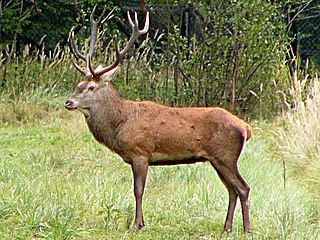
Cervus is a genus of deer that primarily are native to Eurasia, although one species occurs in northern Africa and another in North America. In addition to the species presently placed in this genus, it has included a whole range of other species now commonly placed in other genera. Additionally, the species-level taxonomy is in a state of flux.

Salpingidae or narrow-waisted bark beetles is a family of beetles in the superfamily Tenebrionoidea. The species are small, about 1.5 – 7 mm in length. The family is globally distributed and consists of about 45 genera and 300 species, which are generally found in the temperate regions of both hemispheres. The family is mainly associated with plants as well as with ascomycete and hyphomycete fungi. Some members of the family are associated with unusual habitats, like Aegialites and Antarcticodomus, which are found in coastal areas including the intertidal zone, with former feeding on algae.

Hexarthrius parryi, the fighting giant stag beetle, is a species of large stag beetles. It belongs to the genus Hexarthrius of the tribe Lucanini. It is classified under the subfamily Lucaninae of the stag beetle family Lucanidae.

Chrysochroa fulminans is the type species of jewel beetle in its genus; it belongs to the family Buprestidae, tribe Chrysochroini and subgenus Chrysochroa.

Semiardistomis is a genus of beetles in the family Carabidae, containing the following species:
Oxylymma is a genus of beetles in the family Cerambycidae. The genus occurs in Central and South America, from Guatemala to Bolivia and Brazil.
Phespia is a genus of beetles in the family Cerambycidae. It occurs in South and Central America.
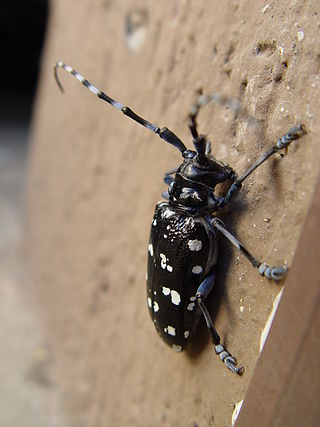
Anoplophora is a genus of beetles in the longhorn beetle family (Cerambycidae). They are native to Asia. Most are large and colorful and thus are depicted in artwork and sought after by beetle collectors. The genus also includes several notorious pest insects.
Mycerinopsis is a genus of beetles in the family Cerambycidae, containing the following species:
Rhadia is a genus of longhorned beetles in the family Cerambycidae. This genus has a single species, Rhadia pusio, found in Papua New Guinea.
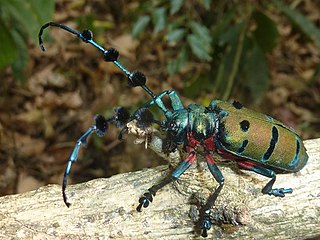
Thysia wallichii is a species of longhorn beetle. It is typically 33–40 mm (1.3–1.6 in) long and native to the northern part of South Asia, southern China, Mainland Southeast Asia and the Greater Sundas. It is the only species in the genus Thysia and it was described by Hope in 1831.

Cacia is a genus of longhorn beetles of the subfamily Lamiinae.

Rhytiphora is a genus of flat-faced longhorn beetles in the Pteropliini tribe of the subfamily Lamiinae. The genus was first described in 1835 by Jean Guillaume Audinet-Serville.
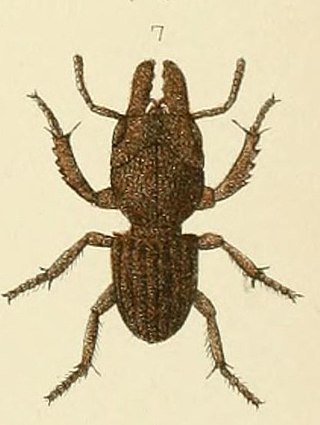
Geodorcus novaezealandiae is a large flightless species of stag beetle in the family Lucanidae. It is the type species and smallest member of the genus Geodorcus. It is endemic to New Zealand.

Micropeplus is a genus of rove beetles in the family Staphylinidae. There are at least 40 described species in Micropeplus.

Mimopeus is a genus of darkling beetles in the family Tenebrionidae, first described by Francis Polkinghorne Pascoe in 1866. It is endemic to New Zealand.
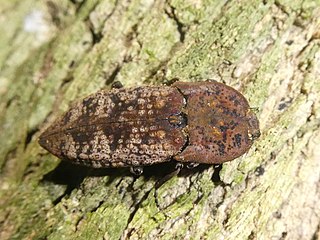
Amychus is a genus of beetles belonging to the family Elateridae. This genus is endemic to New Zealand.

Coptocercus crucigerus is a species of beetle in the family Cerambycidae, first described by Frederick William Hope in 1842 as Stenochorus cruciger, from a specimen collected in Port Essington (Darwin). In 1929, Herbert James Carter assigned the species to the genus Coptocercus, and also synonymised it with Phoracantha politaPascoe, 1863.

Dryocora is a genus of beetle in the family Prostomidae. It was discovered in 1686 by Francis Polkinghorne Pascoe and is found in Southern Australia, Tasmania and New Zealand.


















